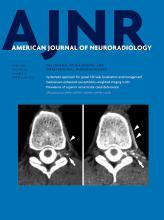Article Figures & Data
Tables
- Table 1:
Outcomes after flow diversion treatment of distal anterior circulation intracranial aneurysms
Variables Results of Systematic Review and Meta-Analysis No. of Articles Statistic (95% CI) (I2) Angiographic outcomes Rate of successful stent deployment 422/429 = 97.5% 29 (96–98.9) (I2 = 0%) Immediate aneurysm occlusion rate (OKM C–D) 44/333 = 11.1% 18 (6.5–16) (I2 = 55%) Overall long-term aneurysm occlusion rate (OKM C–D) 295/364 = 82.7% 28 (77.4–87.9) (I2 = 52%) Long-term occlusion rate (MCA location) 163/206 = 78% 13 (69–88) (I2 = 73.7%) Long-term occlusion rate (AcomA location) 91/105 = 88% 13 (82–94) (I2 = 0%) Long-term occlusion rate (DACA location) 41/53 = 82% 6 (70.7–90.7) (I2 = 0%) Long-term occlusion rate (FRED device) 37/53 = 73.8% 7 (60.1–87.5) (I2 = 31.7) Long-term occlusion rate (p64 device) 18/22 = 82% 2 (64–98) (I2 = 41.7%) Long-term occlusion rate (PED device) 143/165 = 87.3% 13 (82.4–92.3) (I2 = 0%) Long-term occlusion rate (Surpass device) 11/14 = 80.9% 2 (55.5–98) (I2 = 29.3%) Treatment-related complications and clinical outcomes Overall treatment-related complications 63/410 = 12.5% 28 (9–16) (I2 = = 18.8%) Treatment-related complications (MCA location) 44/231 = 18% 12 (12–25) (I2 = 42%) Treatment-related complications (AcomA location) 14/126 = 8% 10 (3–13) (I2 = 0%) Treatment-related complications (DACA location) 5/53 = 9% 6 (5–17) (I2 = 0%) Periprocedural/early complications (within 30 days) 30/418 = 5.9% 28 (3.7–8) (I2 = 0%) Delayed complications (after 30 days) 35/418 = 6.5% 28 (3.4–8.4) (I2 = 20%) Transient complications 37/418 = 6.7% 28 (4.4–9) (I2 = 0%) Permanent complications 29/418 = 5.4% 28 (3.3–7.5) (I2 = 0%) Treatment-related complications (FRED device) 9/66 = 11.7% 28 (3.2–20.3) (I2 = 29%) Treatment-related complications (p64 device) 3/23 = 12.5% 2 (1–26) (I2 = 0%) Treatment-related complications (PED device) 20/159 = 9.2% 12 (4.9–13.5) (I2 = 0%) Treatment-related complications (Silk device) 2/20 = 8.2% 3 (3.2–19.5) (I2 = 0%) Treatment-related mortality 5/374 = 2.2% 23 (0.8–3.7) (I2 = 0%) Overall rate of good neurologic outcome 290/304 = 97% 23 (96–99) (I2 = 0%) Type of complications and location Thromboembolic complications 54/418 = 9.9% 29 (7–12.7) (I2 = 6.6%) Thromboembolic complications (MCA location) 40/239 = 14.6% 12 (9–20) (I2 = 33%) Thromboembolic complications (AcomA location) 10/126 = 6% 10 (2–10) (I2 = 0%) Thromboembolic complications (DACA location) 4/53 = 7% 6 (1.5–16) (I2 = 0%) Hemorrhagic complications 7/418 = 2.6% 29 (1.1–4) (I2 = 0%) Premature discontinuation of AT and related ischemic events 6/418 = 2.8% 29 (1.3–4.3) (I2 = 0%) Note:—OKM indicates O'Kelly-Marotta scale.
- Table 2:
Univariate and multivariate analysis of predicting factors for aneurysm occlusion and treatment-related complications
Univariate, P Value Univariate OR Multivariate Odds Ratio 95% CI P Value Independent variables for occlusion Type of FD (PED vs other) .002 1.4 2.6 1.6–5.3 .02a No. of FDs (multiple vs single) .07 1.3 2.3 0.8–7.2 .08 Aneurysm size (large vs small)b .3 1.1 FD + coils vs FD alone .006 1.9 1.8 0.8–3.4 .11 Aneurysm location (MCA vs AcomA/DACA) .01 0.9 0.5 0.2–0.7 .03a Independent variables for complications Type of FD (PED vs other) .5 1.3 No. of FDs (multiple vs single) .4 1.5 Aneurysm size (large vs small)b .06 2.4 2.2 1–8.3 .03a FD + coils vs FD alone .5 0.9 Aneurysm location (MCA vs AcomA/DACA) .01 2.9 1.8 1.1–7.6 .02a












